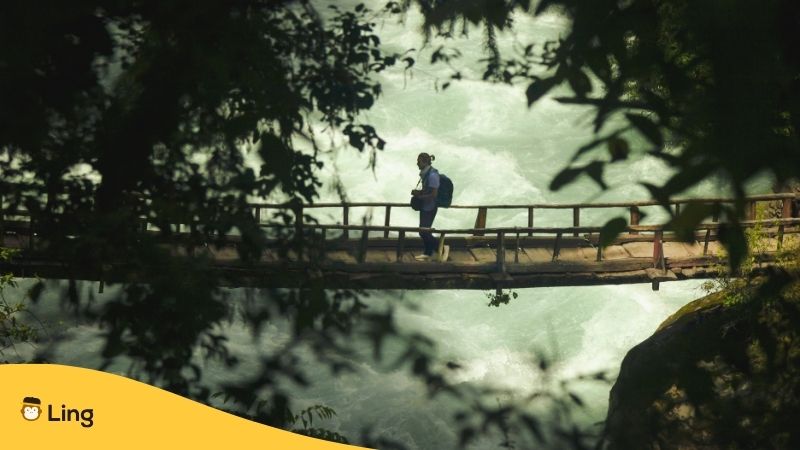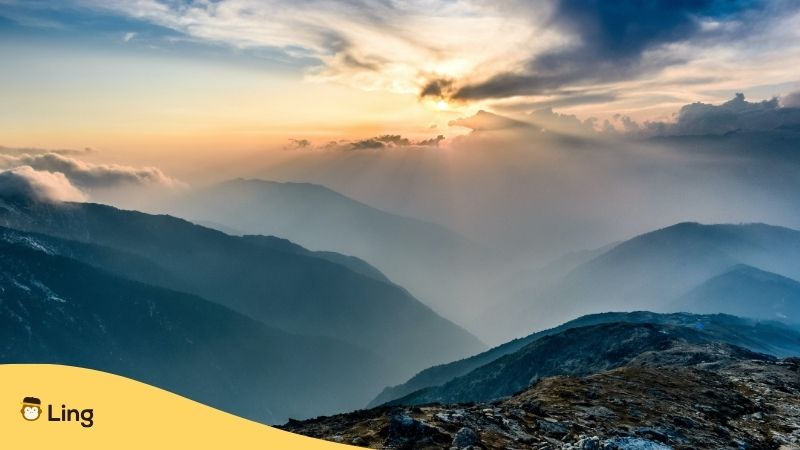Nepal, a small country in the heart of the Himalayas is all about rugged terrain, impressive views, and awe-inspiring natural beauty. From the towering peaks of the Himalayan range to the lush green valleys learning Nepali words for nature is handy for when you visit so you can describe the amazing world you find yourself in.
This time, we will be looking at some of the Nepali words related to nature and the environment you can use to describe the wonders all around you in this magnificent Himalayan country.
Nepali Words For Nature
In Nepali, a language intertwined with the country’s breathtaking landscapes, nature is beautifully described. “Prakriti” (प्रकृति) embodies the essence of nature, while “Parbat” (पर्वत) portrays majestic mountains. “Jal” (जल) symbolizes the significance of water in Nepal’s ecosystem.
So, come let’s take a look at some other words related to nature in the Nepali language.
Mountain – Parbat (पर्वत)
What better word to begin with? Nepal is renowned around the globe for its massive mountains, and the Nepali word “Parbat” (पर्वत) is at the heart of its natural and environmental vocabulary. The towering peaks of the Himalayas, including the iconic Mount Everest (सगरमाथा – Sagarmatha in the Nepali translation), are a source of national pride and a symbol of Nepal’s natural magnificence.
Forest – Jangala (जङ्गल)
Nepal may be mountainous but the country is also covered in forests, from subtropical jungles in the lowlands to temperate and alpine forests in the higher regions. The Sanskrit word “Jangala” (जङ्गल) rather oddly means “arid, sparsely grown with trees” but is the reason different languages have words similar to “jungle” in their lexicon for “dense growth of trees and other tangled vegetation.” In Nepal, forests not only provide habitat for countless animals but also play a crucial role in maintaining the ecological balance and supporting the local livelihoods of Nepali humans.

Weather – Mausam (मौसम)
The word “मौसम” (Mausham) is used to describe the ever-changing weather patterns in Nepal. The country experiences a wide range of climates, from subtropical in the lowlands to alpine conditions in the mountains. Understanding the “मौसम” is vital for planning agricultural activities, trekking and hiking expeditions, and daily life in Nepal.
Seasons – Mausamharu (मौसमहरू)
Nepal experiences distinct “Mausamharu” (मौसमहरू), or seasons, throughout the year. These seasons dictate agricultural practices, festivities, and even tourism patterns. The country’s diverse geography ensures that there is always a place to enjoy each season.
Wildlife – Vanyajantu (वन्यजन्तु)
Nepal’s national parks and protected areas are teeming with diverse wildlife, from the elusive Bengal tiger (बंगाल टाइगर) to the mischievous monkeys or “bandar” (बन्दर). The term “Vanyajantu” (वन्यजन्तु) encompasses this wealth of untamed living beings and underscores the importance of conservation efforts and the relevant protection of the environment.
Birds – Caraharu (चराहरू)/ Pakshi (पक्षी)
Similar to the presence of lots of terrestrial wildlife, there are over 900 species of birds found in various ecosystems in Nepal. From the lowlands to the high mountain regions in Nepal, this country’s avian diversity is astounding. The word “Pakshi” (पक्षी) encompasses all of our feathered friends and Nepal recognizes the importance of bird conservation in the country.
River – Nadi (नदी)
Rivers are the lifeblood of Nepal, providing quality fresh water for drinking, agriculture, and hydropower generation. The word “Nadi” (नदी) represents the intricate network of rivers that crisscross the country, including the powerful Koshi, the pristine Gandaki, and the sacred Bagmati. Nepali culture is deeply intertwined with its rivers, which are often worshipped as goddesses.
Lake – Taal (ताल)
Nepal is blessed with numerous lakes, both big and small, scattered across its picturesque landscapes. These “Taal” (ताल) serve as serene havens for wildlife and offer breathtaking reflections of the surrounding mountains. Prominent lakes like Rara, Fewa, and Gosaikunda are not only natural wonders but also cultural and spiritual landmarks.

Cave – Gufa (गुफा)
Nepal is home to many hidden treasures below the earth as well as above, including stunning limestone caves like the Siddha Gufa and Gupteshwor Caves. The word “गुफा” (Gufa) denotes these geological wonders, which often hold cultural and religious significance.
National Park – Rastriya Nikunja (राष्ट्रिय निकुञ्ज)
Nepal’s national parks and conservation areas play a vital role in protecting the country’s natural heritage. The word “राष्ट्रिय निकुञ्ज” (National Park) signifies these designated areas, which are not only havens for wildlife but also popular destinations for eco-tourism and adventure enthusiasts keen to get out and enjoy the natural world.
Snow/Ice – Barf (बर्फ)
Nepal’s high mountains are often covered in a pristine blanket of “Barf” (बर्फ). Snow and ice not only shape the landscapes but also provide a source of fresh water for downstream communities.
Waterfall – Jharna (झरना)
Nepal’s rugged terrain gives rise to countless “Jharna” (झरना), or waterfalls, each with its unique charm. Waterfalls are not only natural marvels but also sources of hydroelectric power and recreation.
Conservation – Sanrakshan (संरक्षण)
Last but not least, “Sanrakshan” (संरक्षण) is a crucial word in the Nepali language. It emphasizes the importance of environmental conservation efforts by human beings to protect Nepal’s unique, fragile ecosystems and natural resources for future generations.
The Nepali language is a treasure trove of words that reflect the deep connection between the people of Nepal and their stunning natural environment. These words not only describe the physical elements of nature but also encompass the cultural, spiritual, and practical aspects of life in this remarkable country.
Learn More Nepali Words With Ling
Increasing your Nepali vocabulary while out and about in the heart of nature is an excellent way of increasing your Nepali word bank. By having Ling on your phone or tablet you can continue learning Nepali wherever you are. The Ling app has everything you need to improve your conversation, reading, and writing through lessons created by native Nepali speakers and fun interactive games and quizzes. The Ling app is available to try at Google Play and the App Store today.



































































